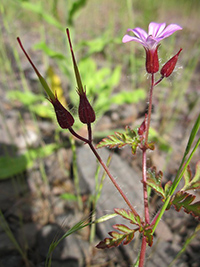Table of Contents
Be careful with the dragon’s blood plant, as it can be mistaken for poison hemlock. Both plants have unpleasant smells and very similar leaves. However, the dragon’s blood plant’s rose flowers and lamp-shaped dried fruits easily distinguish it.
- Expertly extracted to support healthy function of the digestive system.
- Prepared from the sustainably wildcrafted sap of Croton lechleri trees from the Peruvian Amazon.
- Rapidly absorbed liquid extract.
- Gluten-free and non-GMO.
- Herb potency assured through High Performance Thin Layer Chromatography (HPTLC) analysis.

Healing Properties and Uses
The entire plant contains a bitter substance (geranium), an essential oil that gives it its typical aroma. It also contains vital amounts of tannin, which determines its astringent action. It has astringent, diuretic, and blood-thinning properties and is a mild hypoglycemic when used internally. It is used in diarrhea and edema (liquid retention) and to complement a diabetic diet.
Today, it is mainly used externally because of its astringent and vulnerary (healing) properties in the following cases:
- Eye afflictions: eye irritation, eye drainage, conjunctivitis.
- Mouth afflictions: stomatitis, pharyngitis, gingivitis.
- Skin eruptions: herpes, shingles, eczemas, and skin inflammations.

Dragon’s Blood Plant Scientific Facts
- Other names: Herb Robert, storkbill, Wild Crane’s Bill.
- French: Herbe a Roberto.
- Spanish: Hierba de San Roberto.
- Environment: It usually grows in shady places along walls, forests, and slope edges throughout Europe and North America.
- Description: This herbaceous plant in the family Geraniaceae grows from 20 to 60 cm high. It is reddish and has a typically unpleasant smell. Its pink flowers appear in pairs.
- Parts of the plant used medicinally: The entire plant.

How to use Dragon’s Blood
- Decoction with 20 g of plant per liter of water, drinking three or four cups daily.
- Essence. The usual dose is two to four drops three times a day.
- Eye and mouth rinse with 40 g of plant decoction per liter of water.
- Compresses with the same decoction (40 g per liter).
Frequently Asked Question
What active compounds are responsible for the potential benefits of dragon’s blood?
Dragon’s blood contains numerous bioactive compounds. Some key ones include:
Taspine: An alkaloid with documented wound healing, antimicrobial, and potentially anti-inflammatory effects.
Proanthocyanidins: Potent antioxidants that may protect cells and combat inflammation.
Phenols and other compounds contribute to dragon’s blood’s vast potential benefits.
Can dragon’s blood help heal wounds?
Evidence suggests yes! Studies indicate dragon’s blood may promote faster wound healing by:
Stimulating collagen formation: Essential for tissue repair.
Forming a protective barrier: This helps prevent infection.
Reducing inflammation: Key for optimal wound healing.
Important: Always consult a doctor for severe wounds or if an infection is suspected.
Does dragon’s blood have any effect on digestive health?
Traditionally, it’s been used for conditions like diarrhea. Some research supports this:
Studies show it might combat bacteria linked to diarrhea or ulcers. It may reduce inflammation in the gut, potentially helpful for conditions like IBS.
Caution: More extensive human studies are needed. It’s not a substitute for prescribed medications.
Are there skincare benefits to using dragon’s blood?
Emerging research and product claims point to yes:
Antioxidant power: May protect against environmental skin damage.
Anti-inflammatory: Potentially soothing for eczema or acne-prone skin.
Hydration boost: This can enhance the skin’s moisture barrier.
Note: Individual results vary, and more research is always helpful.
Is there evidence for dragon’s blood’s anticancer potential?
Research is VERY early. Laboratory studies suggest possible anti-tumor effects, but this does NOT translate to a treatment or cure for human cancers.
How do I use dragon’s blood safely?
Topical (on the skin): Most common, generally safe for short-term use on minor wounds or in skincare products. Look for reputable products.
Internal: Consult a doctor FIRST. Dosing varies by condition, and it may interact with medications.
Never: Use on deep wounds, burns, or without medical supervision if you have health conditions.
Can anyone use dragon’s blood?
Generally safe: For most healthy adults in topical form. HOWEVER:
Pregnancy/breastfeeding: Safety unknown; avoid use.
Allergies: If possible, do a patch test before widespread application.
Health conditions/medications: Consult a doctor to avoid potential interactions.
Are there side effects associated with dragon’s blood?
Usually well-tolerated topically. Potential side effects are mostly linked to internal use and might include:
Stomach upset* Diarrhea
Skin reactions (rarely)
Where can I find reliable information on dragon’s blood research?
ScienceDirect: (https://www.sciencedirect.com/).
University websites/studies: Look for reputable medical and research institutions.
What is the bottom line of dragon’s blood and health?
It is promising for wound healing and has potential in other areas, but it is NOT a miracle cure.
Research is ongoing. Always speak to a doctor before using it for any specific health condition.
DISCLAIMER: All content on this website is presented solely for educational and informational objectives. Do not rely on the information provided as a replacement for advice, diagnosis, or treatment from a qualified medical expert. If you are pregnant, nursing, or have any preexisting medical concerns, talk to your doctor before using any herbal or natural medicines.
REFERENCES
- George D. Pamplona-Roger, M.D. “Encyclopedia of Medicinal Plants.” George D. Pamplona-Roger, M.D. Encyclopedia of Medicinal Plants. Ed. Francesc X. Gelabert. Vols. 1 San Fernando de Henares: Editorial Safeliz, 2000. 137. Print. [dragon’s blood plant]
- Dragon’s blood: botany, chemistry, and therapeutic uses” (Gupta, Kumar, et al.):https://pubmed.ncbi.nlm.nih.gov/18060708/
- Healthline: https://www.healthline.com/health/dragons-blood
- Dr. Axe: https://draxe.com/nutrition/dragons-blood/
- PubMed: https://pubmed.ncbi.nlm.nih.gov/
Last update on 2024-07-22 / Affiliate links / Images from Amazon Product Advertising API





